Painting conservators are trained to examine paintings from the support to the visible paint layers and everything in between. Following an initial assessment, they devise a proposal to treat condition issues that are structural in nature in addition to those that are aesthetic and visible to the eye. While less common, structural treatments may require the use of different tools and techniques to address problems with the stretcher and support layers. Canvas supports can be remarkably reactive to changes in relative humidity because the linen fibers swell and contract in response to moisture. Additionally, rabbit-skin glue is usually present in the canvas as a sizing material. Collagen-containing adhesives expand with contact to moisture and have a tendency to shrink when they dry out.
Treatment of Jean Dubuffet's "Façades d’Immeubles (Building Façades)," 1946
Ana Alba, Contractor, Painting Conservation Department
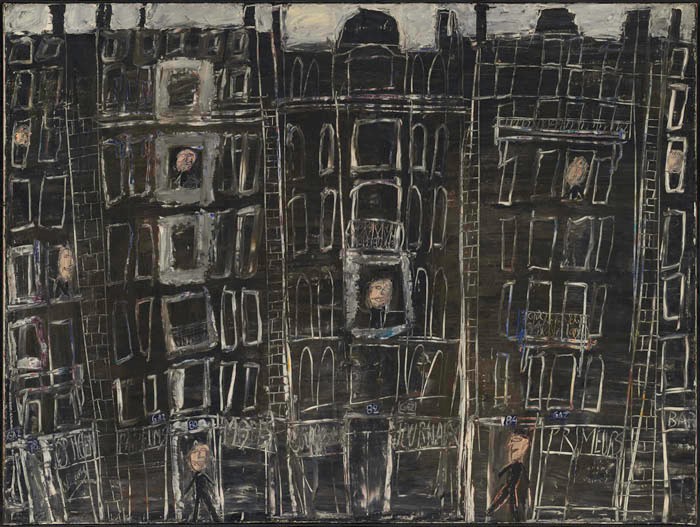
Figure 1 Dubuffet’s Façades d’ Immeubles (Building Façades), before treatment, normal illumination
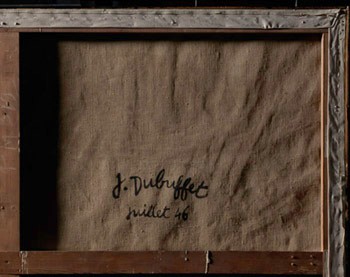
Figure 2 Reverse of the canvas in raking light, showing undulations
Prior to its acquisition in 1995, Jean Dubuffet’s Façades d’ Immeubles (Building Façades) experienced shrinkage of the original linen canvas support, mainly in the horizontal direction, due to changes in relative humidity (see Figure 1). Due to this shrinkage, the painting exhibited distracting undulations throughout (Figure 2), and 1/4” of the tacking margin, the portion of the canvas that attaches to the stretcher, was visible on either side of the picture plane. Because this margin was not original and was visually distracting, the painting was brought to the conservation lab for structural treatment.
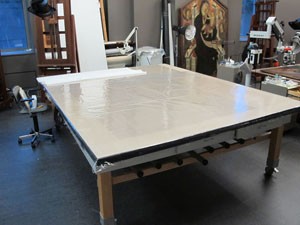
Figure 3 Hot/Suction table unit
To relax the severe undulations that had developed over time, the painting needed an overall humidification treatment. Undulations of a canvas support can be relaxed with gentle exposure to humidity. When dried while planar or under tension, undulations are more likely to remain planar over time. The painting conservation department is equipped with a hot/suction table that measures a sizeable 95” x 119” (see Figure 3) that can accommodate the many oversize works on canvas in the Gallery's collection. Heat/suction tables apply gentle heat and pull an even vacuum at the same time, enabling a conservator to humidify and then dry a painting while under pressure. The surface of the table is comprised of a woven Teflon fabric over a channeled sub-support to ensure even suction. The table distributes even heat across its surface and can obtain a temperature hot enough to soften most adhesives without compromising original paint layers.
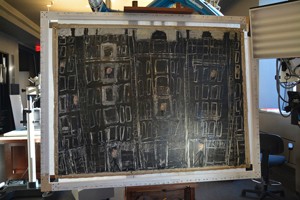
Figure 4 The painting is applied to a working stretcher,
providing access to the canvas layer
In order to treat Dubuffet’s Façades d’Immeubles, the painting was removed from its original stretcher and applied to a working stretcher (Figure 4), allowing the conservator unobstructed access to the reverse. Working stretchers also keep the painting in tension and prevent the canvas from shrinking during the course of the treatment.
The painting was placed over moistened blotters and was covered with a sheet of Dartek on the heat/suction table to create a humidity chamber (Figure 5). During the humidification process, heat was gradually applied in order to gently relax both the paint and support layers. Once the paint and canvas layers were sufficiently relaxed, pressure was applied by pulling a low vacuum through the canvas support until the painting was completely dry and the canvas remained in plane (Figure 6). Small, soft weights were applied to increase the pressure locally, where necessary.
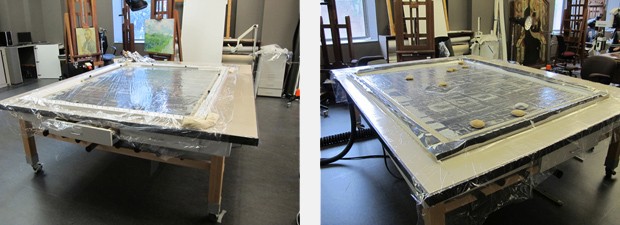
Figure 5 (left) The painting in a humidification chamber on the heat/suction table
Figure 6 (right) The painting being pulled under a vacuum on the heat/suction table
Following treatment of the undulations, the painting was restretched onto its original stretcher. The painting was remeasured and the stretcher was adjusted to conform to the originally intended margins (Figure 7). Semirigid panel inserts were added to the reverse to provide additional support and reduce vibration during handling.
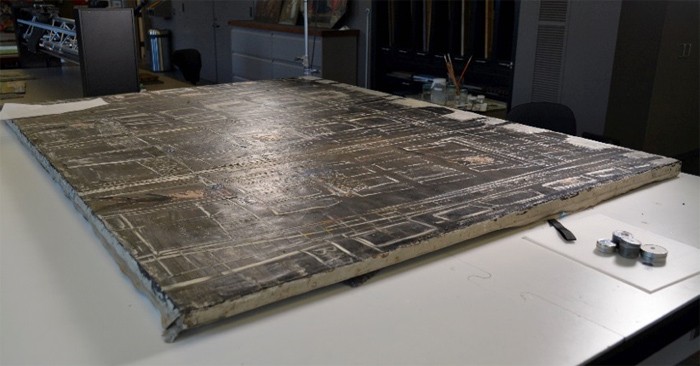
Figure 7 During restretching of the painting, following humidification treatment
Reference:
Mecklenberg, M. F., and C. S. Tumosa. "Mechanical Behavior of Paintings Subjected to Changes in Temperature and Relative Humidity." In Mervin Richard, Marion F. Mecklenburg, and Ross M. Merrill, eds., Art in Transit. Washington, DC, 1991.
The White Horse
Examine the treatment project conducted on John Constable's The White Horse.
Jean Dubuffet's Façades d'Immeubles
Learn about what happens to the canvas support for paintings as it ages.
Conservation Division
National Gallery of Art
2000B South Club Drive
Landover, MD 20785
[email protected]